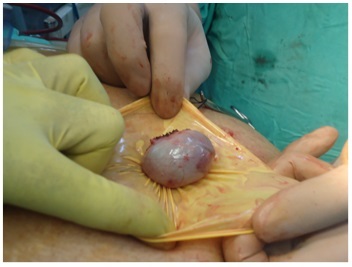A safe and inexpensive technique of retrieval of gallbladder specimen after laparoscopy
Keywords:
Laparoscopic cholecystectomy, endobag, gall bladder specimen retrievalAbstract
Laparoscopic cholecystectomy is associated with greater chances of intra abdominal stone spillage and implantation and port site contamination when gallbladder specimen is retrieved without endobag. Economical sterile surgical gloves can be used instead of expensive commercial endobags to retrieve the gallbladder specimen and also intra abdominal spilled stones safely without complications. Evaluate the safety and cost effectiveness of sterile surgical glove endobag technique for retrieval of gallbladder specimen after laparoscopic cholecystectomy. Four hundred patients with the diagnosis of symptomatic uncomplicated cholelithiasis, who underwent laparoscopic cholecystectomy with four port technique, were included in the study. In all these patients sterile surgical hand glove endobag (size 6½, 7) was inserted through 10mm umbilical port and gall bladder specimen was retrieved along with any spilled gallstone. Tense and distended gallbladders with packed stones were decompressed prior to retrieval without enlargement of the facial opening. The whole procedure was done under direct vision. Patients less than 15 years age, known cirrhotic and carcinoma gallbladder were excluded from this study. The whole process is observed for its safety and cost effectiveness. Gall bladder specimen in all four hundred cases, (276 (69%) female and 124 (31%) were male) retrieved through the 10mm umbilical port in surgical glove endobag. In 36 (9%) cases gallbladder was acutely inflamed and oedematous, which were opened and decompressed at the umbilical port site inside the endobag before retrieval. In 20 (5%) patients wound infection observed at the umbilical port site. In 01 (0.25%) patient spilled gall stones were recovered after two years from supra umbilical port presented as a chronic discharging sinus. Surgical glove endobag technique is simple, safe and economical with fewer complications.
References
Kang, K.J., 2003. LimTae Jin. Tip for microlaparoscopic cholecystectomy, easy removal of the gallbladder after laparoscopic cholecystectomy using the three-port technique. Surg Laparosc Endos Percutan Tech., 13, 118–20.
Kang, K.J., Lim, T.J., 2003. Tip for microlaparoscopic cholecystectomy, easy removal of the gallbladder after laparoscopic cholecystectomy using the three-port technique. Surg Laparosc Endosc Percutan Tech., 13, 118–120.
Leggett, P.L., Churchman-Winn, R., Miller, G., 2000. Minimizing ports to improve laparoscopic cholecystectomy. Surg. Endosc., 14, 32–36.
Ali, S.A., Siddiqui, F.G., 2013. Implanted gallstones at port site (A Case Report), World J. Min. Access. Surg., 2013;2:
Diez, J., Arozamena, C., Gutierrez, L., et al., 1998. Lost Stones During Laparoscopic Cholecystectomy. HPB Surg., 11, 105-109. [Pubmed].
Bonar, J.P., Bowyer, M.W., Welling, D.R., 1998. and Hirsch K. The Fate of Retained Gallstones Following Laparoscopic Cholecystectomy. JSLS., Jul-Sep, 2(3), 263-268. [Pubmed].
Zehetner, J., Shamiyeh, A., Wayand, W., 2007. Lost gallstones in laparoscopic cholecystectomy, all possible complications. Am. J. Surg., 193, 73-8.
Hand, A.A., Self, M.L., Dunn, E., 2006. Abdominal Wall Abscess Formation Two Years after Laparoscopic Cholecystectomy., JSLS. Jan-Mar, 10(1), 105-107. [Pubmed].
Shahzad, K., Mian, M.A., Rehman, J.U., 2007. Early Complications of Laparoscopic Cholecystectomy for Calculus Cholecystitis. Pakistan Armed Forces med. J. December., Issue No. 4.
Kumar, T.S., Saklani, A.P., Vinayagam, R., Blackett, R.L., 2004. Spilled gall stones during laparoscopic cholecystectomy, a review of the literature. Postgrad Med. J., 80, 77-79. [Pubmed].
Brock, M., Bordelon, K., Ann, H., Jhon, G., 1992. Hunter. Incision extension is the optimal method of difficult gallbladder extraction at laparoscopic cholecystectomy. Surg. Endose., 6, 225-227.
Machado, M.A.C., Herman, P.A., 2004. simple technique for removal of gallbladder during micro laparoscopic cholecystectomy, Surg. Endose., 18,1289-1290.
Helme, S., Samdani, T., Sinha, P., 2009. Complications of spilled gallstones following laparoscopic cholecystectomy, a case report and literature overview. J. Med. Case. Reports., 3, 8626.
Golash, V., Rahman, S., 2006. Railroading removal of gall bladder in laparoscopic cholecystectomy. J. Minim. Access. Surg., 2(1), 31–32.
Diez, J., Arozamena, C., Gutierrez, L., et al., 1998. Lost Stones During Laparoscopic Cholecystectomy. HPB Surg., 11,.105-109.
Sathesh-Kumar, T., Saklani, A.P., Vinayagam, R., Blackett, R.L., 2004. Spilled gallstones during laparoscopic cholecystectomy, a review of literature. Postgrad Med. J., 80, 77-9.
Raj, P.K., Katris, F., Linderman, C.G., Remine, S.G., 1998. An inexperience laparoscopic specimen retrieval bag. Surg. Endosc., 12, 83.
Bisgaard, T., Klarskov, B., Trap, R., Kehlet, H., Rosenberg, J., 2002. Microlaparoscopic vs conventional laparoscopic cholecystectomy, a prospective randomized double-blind trial. Surg. Endosc., 16, 458–464

Published
How to Cite
Issue
Section
Copyright (c) 2013 A. I. Memon, S. A. Ali, A. G. Soomro, A. J. Siddique

This work is licensed under a Creative Commons Attribution-NonCommercial-NoDerivatives 4.0 International License.



